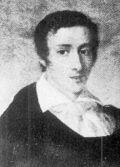1st piano concerto (Chopin)
Frédéric Chopin completed the 1st Piano Concerto op. 11 in E minor at the age of 20. He dedicated it to Friedrich Kalkbrenner and brought it on October 11, 1830 - on the eve of the November Uprising - the National Theater for the premiere . He told Tytus Woyciechowski of "lively bravo calls".
background
Chopin's two piano concertos , the one in F minor op. 21 and his op. 11, were composed around the same time. It is certain that the concerto in F minor was actually his first piano concerto, and therefore No. 1 his second. It is not entirely clear why they were published in reverse order. It is assumed that Chopin, who took his final stay in Paris in 1831 , offered some of his works there, including the two concerts, to a publisher, but the latter, due to the high degree of difficulty of the pieces, was intended for "home use" by amateur musicians were not suitable, only accepted one thing, namely the concerto in E minor.
The question of whether Chopin orchestrated his piano concertos himself has not been answered. The fact that Chopin composed almost exclusively for the piano and has always admitted his passion for this instrument is no reason to doubt it. He mastered orchestration, if not to the perfection of other composers who have also dedicated themselves to orchestral works. However, his orchestration of the concerts shows that he viewed the role of the orchestra more as a decorative accessory. It can introduce, lead over and play the final passages, but where the piano appears, it is withdrawn and reduced to a narrow accompaniment for the solo instrument. In contrast to the concerts of the Viennese Classic and also many romantic concerts, Chopin provided almost no dialogue between the solo instrument and the orchestra, they mostly just alternate.
Sentence names
- Allegro maestoso
- Romance - Larghetto
- Rondo - Vivace
The first sentence
In the formal structure of the first movement, Chopin followed the example of the brilliant virtuoso concerto, as he got to know, for example, from Johann Ladislaus Dussek and Johann Nepomuk Hummel . He was not interested in a dialectical opposition and togetherness of soloist and orchestra as with Beethoven, nor a kind of symphonic concert with an interweaving of piano part and orchestra as in the beginning with Carl Maria von Weber. The soloist and the representation of his expressive possibilities and technical abilities are in the foreground with Chopin.
The first movement of the E minor concerto has three themes exposed by the orchestra . The first theme is taken up briefly by the piano (bar 139), but immediately (bar 155) transferred to the lyrical 2nd theme in E minor, the melody of which is counterpointed in the bass by the head motif of the 1st theme. The third, also lyrical theme (bar 222), which opposes the first two themes in E major, is also taken over by the piano. The implementation starts in clock 385, the piano comes back on the second theme and develops it further. In the following, however, like the second topic, it is completely neglected in terms of implementation. In essence, it is only a shortened motif of the first theme, which is played by the orchestra in a modified form, while in the piano part capricious and technically demanding runs and figures have to be mastered. The recapitulation begins again in bar 486 with the orchestra and its opening theme. The coda , whose bass trills in the left hand give the concert a somber touch, demands the pianist's highest technical ability, which makes the lack of a solo cadenza almost superfluous.
The 2nd movement
E major, B major and G sharp major determine the basic character of this romance. A dramatic middle section in C sharp minor contrasts with the vocal song themes that recur and are varied several times. Chopin demonstrates his glittering but never exuberant art of ornamentation, which gives the rhythmically free, dolcissimo , leggerissimo and legatissimo , but also con forza and veloce performed ornamental melodies a luminous shine. The relationship to the nocturnes composed later is great. There are echoes, for example, in Nocturne op. 32, No. 1 in B major. There the mood is broken by a sudden, recitative coda, here in the romance by the rondo that follows the attacca .
The 3rd movement
The rondo , performed throughout vivace , makes use of stylized folk music. The rondo theme in particular is modeled on Krakowiak melodies. Its syncopated opening rhythm in 2/4 time also runs through the entire thematic material of the movement. This rondo offers the soloist the opportunity to demonstrate his pianistic skills full of enthusiasm in rapid passages and quick-tempered scenes, sometimes in dialogue with the orchestra. The dramatic intensification in the coda forms the great end of the concert.
Chamber music version
The version with string quintet protects the concert from any "plushness" and makes the piano setting light and transparent. Kit Armstrong played it with five members of Ensemble Resonanz at the Mecklenburg-Western Pomerania Festival in 2018 .
Web links
- 1st Piano Concerto : Sheet Music and Audio Files in the International Music Score Library Project
- www.kreusch-sheet-music.net - Sheet music in the public domain of the complete work “1. Piano concerto "
